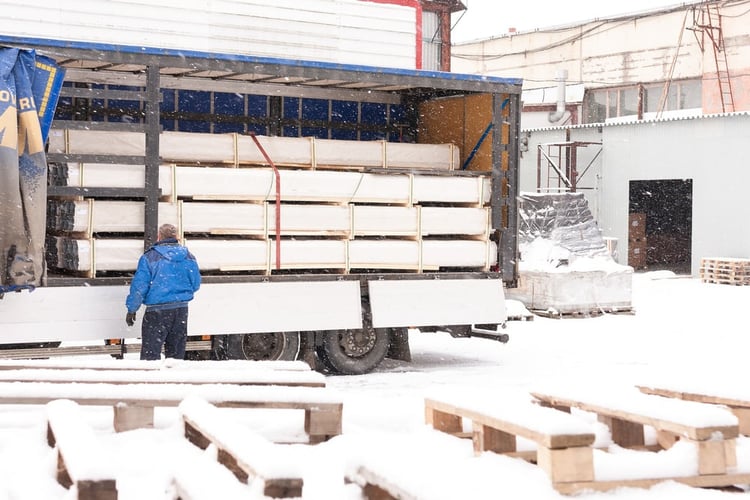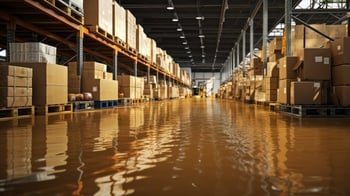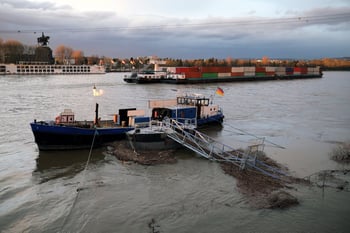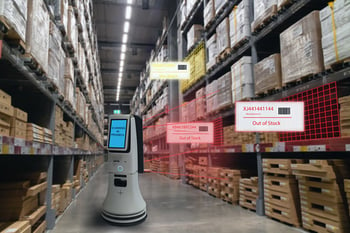
From sweltering summer temperatures and frigid winters to powerful storms, flooding, and even wildfires, there are certain precautions (like having an emergency action plan) that can help keep everyone safe during a storm. Because of factors like scaffolding, large, open indoor spaces, electrical equipment, and heavy machinery, proper protocols during severe weather may be a matter of life and death.
Workplace Hazards Associated With Unfavorable Weather Conditions
It’s tough to argue that weather conditions seem to be getting more dangerous and extreme with each passing year. Storms are stronger and last longer, temperatures are higher in the summer, and some events are becoming more unpredictable.
Extreme temperatures, high winds, and wet conditions can pose a significant threat to your warehouse or distribution center’s employees and overall productivity. For example, warehouse workers generally work in open spaces, at heights, and around moving machinery, exposing them to a wide variety of safety hazards.
When you mix in unfavorable weather conditions with existing hazards, a warehouse can become even more dangerous. Some of the most common hazards associated with extreme weather conditions include:
 Slipping, tripping, and falling
Slipping, tripping, and falling- Other falls and related injuries
- Falling objects
- Electrocution
- Lightning strikes
- Floods
- Cold stress
- Hypothermia
- Heat exhaustion
- Heat stroke
- Dehydration
- Burns
Promoting Warehouse Safety in Extreme Weather Conditions
An employer must identify all relevant workplace hazards that might materialize due to a weather-related event and implement the proper protections to keep employees safe from harm. Employers can choose from a variety of measures, such as hazard elimination, administrative controls, engineering controls, or the use of personal protective equipment (PPE) to safeguard workers against extreme weather conditions.
Another aspect of warehouse safety is proper preparedness. Specifically, the Occupational Health and Safety Administration (OSHA) requires that employers have a written emergency action plan in place that includes emergencies caused by extreme weather. Here are some ways warehouses can address safety issues related to specific extreme weather conditions.
Extreme Winter Weather
 It would be tough to avoid operating your warehouse during extreme winter weather. After all, the holiday season is the busiest time of the year for most distribution centers. But the potential for serious accidents is much higher when there are icy and cold conditions, requiring that your business take some precautions.
It would be tough to avoid operating your warehouse during extreme winter weather. After all, the holiday season is the busiest time of the year for most distribution centers. But the potential for serious accidents is much higher when there are icy and cold conditions, requiring that your business take some precautions.
The outside grounds around your warehouse should be cleared of any snow and ice. They should also be regularly salted to prevent slip and fall accidents. Because ice melts and creates slush and puddles, keep the inside of the warehouse just as clean.
Employees should be encouraged to wear warm weather gear and reflective clothing so they can be seen in reduced visibility conditions. Finally, ensure that your racking systems and products are standing up to the cold so they don’t create a hazard for your workers.
Sweltering Summer Heat
Trying to beat the heat in a warehouse can be challenging. With the sun heating up the roof of the massive structure, the temperatures inside can rise quickly. Due to the cost of cooling a large, open space, many warehouses don’t have adequate air conditioning.
Extreme heat can lead to loss of fluids, fatigue, and serious heat-related illnesses. Employers should have strict heat prevention measures in place that include:
- Encouraging hydration
- Increasing breaks
- Reducing workload and pace
- Avoiding working outside
- Wearing loose clothing
- Improving ventilation
Employees should be educated about the dangers and signs of heat exhaustion and encouraged to report any issues to their superiors.
Powerful Storms
 Historically, powerful storms like hurricanes, tornados, and blizzards increase the chances of downed trees and power lines, flooding, and power outages, among other serious issues. If your warehouse is still operating when one of these storms comes through, you have a responsibility to protect the health and safety of your employees.
Historically, powerful storms like hurricanes, tornados, and blizzards increase the chances of downed trees and power lines, flooding, and power outages, among other serious issues. If your warehouse is still operating when one of these storms comes through, you have a responsibility to protect the health and safety of your employees.
Having advanced warning systems in place can give your business the information it needs to make informed decisions about operations and loss prevention. You may wish to shut down before a major storm arrives and avoid the potential for damaging machinery or placing workers in harm’s way.
Wildfires
Wildfires are common disasters that can spread quickly to populated areas. If your warehouse is in one of them, your workers are at risk. Planning in advance can protect your structure, inventory, and employees from the destructive impacts of wildfires.
Paying attention to the basics of fire safety should come first. This includes having well-marked exits and pathways throughout your warehouse so employees can escape when necessary. There should also be a robust fire suppression system on site.
Some warehouses are also implementing high-visibility railings and bollards, which are visible in low-light or smokey conditions. Finally, every employee should receive sufficient training on what to do in case of a fire-related emergency.
How Technology Can Help With Workplace Health and Safety
 Having the right systems in place to improve productivity and efficiency in your warehouse is essential. Many businesses in this industry fail to realize that these same systems can also improve workplace health and safety.
Having the right systems in place to improve productivity and efficiency in your warehouse is essential. Many businesses in this industry fail to realize that these same systems can also improve workplace health and safety.
Artificial intelligence (AI) can help warehouses address supply chain challenges. They are also excellent tools to analyze extreme weather risks and help create emergency response plans for various scenarios.
Automation and robotics provide warehouses with the tools they need to fulfill orders more efficiently. These solutions also take some of the most demanding manual jobs away from human workers to reduce instances of heat exhaustion or dehydration during extreme weather conditions.
The warehousing industry will always be one of the more hazardous places to work, but technology and proper planning are playing larger roles in addressing these challenges. To fully capitalize on these capabilities, businesses will need to continue to invest in technology solutions and ensure they are using them to get the most benefits.

